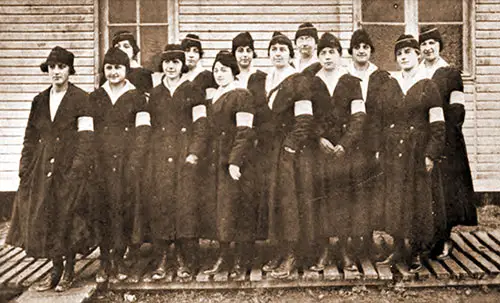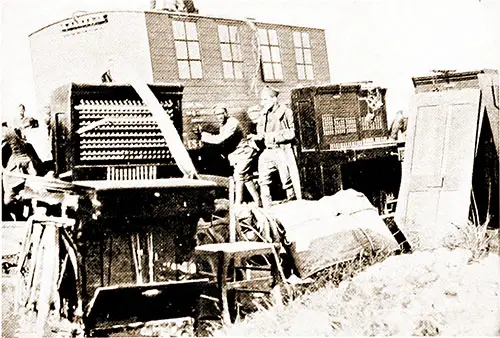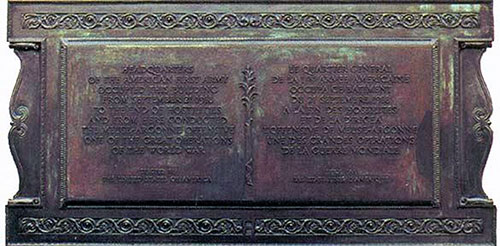The Telephone Girls of Meuse-Argonne - 1921

Telephone Girls on Duty with the Headquarters of the First Army at Souilly, France, during the Meuse-Argonne Operations. Circuits of Victory, 1921. GGA Image ID # 19a21dc64e
In the meantime, while the doughboys kept pegging away at the Hindenburg Line, our friends, the telephone girls who had served so brilliantly through the St. Mihiel engagement, kept plugging away at the switchboard located at First Army Headquarters.
Immediately following the move of First Army Headquarters from Ligny, near St. Mihiel, to Souilly, near Verdun, the six girls who had handled the lines of communication at the Ligny board, together with a seventh, Miss Adele Hoppock, who had joined them, were rushed to the new headquarters.
There were three girls from New York City, Miss Grace Banker, the chief operator of the group. Miss Esther Fresnel and Miss Suzanne Prevot; three from the Pacific Coast, namely, Miss Marie Lange, of Colma, California, Miss Adele Hoppock, of Seattle, Washington, and Mrs. Berthe M. Hunt, of Berkeley, California; and Miss Helen Hill, of New Haven, Connecticut.
Says Mrs. Hunt:
It was the experience of experiences. We packed our suitcases hurriedly, drove to Souilly, ready to do our part in the great Argonne drive, which was launched on September 26th.
When we arrived on September 26th, we found ourselves in a French camp that had been used for over four years, including the period of the famous Verdun drive.
The barracks were flimsy things that had been lined with old newspapers and maps to keep out the cold. The YWCA helped us out by giving us a blanket each, a rug, an oilcloth, and other comforts. In fact, our sitting room (which we acquired later) was furnished with a piano and other things taken from Boche dugouts in the vicinity.
Everyone assisted in making us as comfortable as possible, considering the fact that we were in the advance area, where we could see the red and yellow glare from the shelling and feel the reverberations caused by the booming of the big guns.
The 27th Engineers helped us get settled and made us shelves for our various belongings, washstands, wooden tables, and benches, etc.
At first, we had charge of the operating boards only. You know with our advance units there were two types of board — that used for the ordinary routine of local and long-distance calls, in regard to supplies, transportations, etc.; and that which carried all the messages between the fighting units and the commanding officers directing their movements.
Every order for an infantry advance, a barrage preparatory to the taking of a new objective and, in fact, for every troop movement, came over these "fighting lines," as we called them.
These wires connected the front up with the generals and made it possible for the latter to know exactly what was going on at any moment and to direct operations accordingly.
It was at the operating board, then, that we seven girls were put when we went into the Argonne. At first, the four men already there, two Frenchmen and two Americans, continued to handle the local and long-distance traffic!
It was amusing to see them work. When a call came through in English on the Frenchman's board, the operator would motion to one of the Yanks to come and take it, and when one came to the American that he could not answer, he would call, "Hey, Frog, come over here," and Frenchy would rush around to "stop the gap."
In a short time, however, the entire exchange was handled by girls who could speak French as easily and fluently as English. Several weeks after the first group of seven girls arrived at Souilly, six more came to reinforce the little feminine army.
The new arrivals included Miss Louise Beraud, of Dallas, Texas; Miss Berthe Arland, of Brooklyn, New York; Miss Jennie Young, of Seattle, Washington; Miss Marie Belanger, of Rochester, New York; Miss Leonie Peyton, of Los Angeles, California; and Miss Maria Flood, of Chicago, Illinois.
The effect was immediate, for at a time when the speed of intercommunication was of the essence, the speeding up of telephone service at Army Headquarters, especially on Franco-American calls, could not but be felt all along the line.

Save the Pieces Scene during the Fire Which Broke out at First Army Headquarters, Souilly, France, October 30, 1918. Circuits of Victory, 1921. Official US Army Photograph. GGA Image ID # 19a22947dc

Souilly Marker-1st Army Headquarters. On the outside of the town hall of Souilly, France is a bronze tablet identifying this building as the headquarters of the American First Army towards the end of World War I. Inscribed in French and English is the following: Headquarters of the American First Army occupied this building from September 21, 1918 to the end of hostilities, and from here conducted the Meuse-Argonne Offensive, one of the greatest operations of the war. The tablet is located outside the town hall of Souilly, France, approximately 160 miles east of Paris. American Battle Monuments Commission. GGA Image ID # 19a29b00f4
A. Lincoln Lavine, "Chapter XLVI: When the Band Began to Play," in Circuits of Victory, New York: Country Life Press/Doubleday, 1921, pp. 564-566
